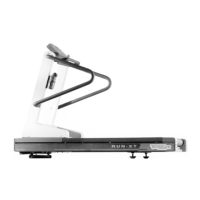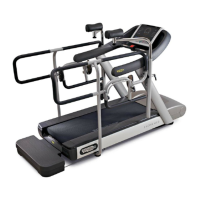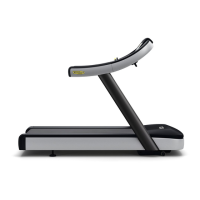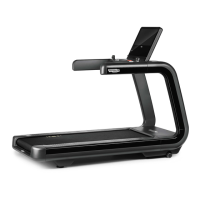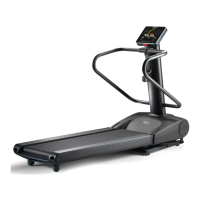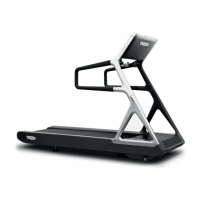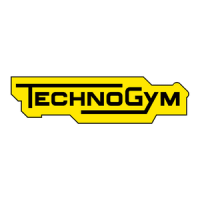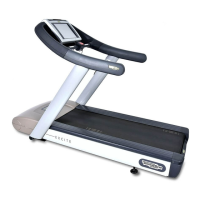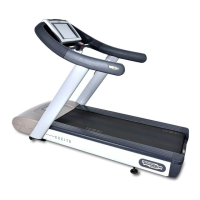Do you have a question about the Technogym Runrace and is the answer not in the manual?
Introduces manual's purpose for qualified technicians.
Outlines recommended steps for planning repair procedures.
Provides essential rules for conducting safe and effective repair procedures.
Details physical dimensions and weight of the machine.
Specifies electrical properties like voltage, frequency, and fuse rating.
Lists operating and storage conditions for temperature and humidity.
Details machine's compliance with relevant European directives and standards.
Presents wiring diagrams for various machine models, crucial for electrical troubleshooting.
Explains how to connect the machine to the Technogym System via upgrade kits.
Details procedure and specifications for connecting a printer to the machine.
Describes connecting external medical devices for exertion tests.
Provides pin-out details for RS-232 and RS-485 serial ports for connectivity.
Lists requirements for correct machine installation, including surface and environment.
Provides a step-by-step guide for the physical installation of the machine.
Guides users through the initial power-on process and basic operational checks.
A flowchart to diagnose and resolve issues where the machine's display fails to turn on.
Step-by-step instructions for safely removing and disassembling the machine's display unit.
Detailed procedure for removing and reassembling EPROMs from circuit boards.
Instructions for safely removing and replacing the backup battery, including voltage checks.
Comprehensive guide to disassembling and reassembling the CPU board, including connector handling.
Instructions for the disassembly and reassembly of the machine's keyboard interface.
Procedure for removing and replacing the cardio receiver unit.
Steps for safely removing and reinstalling the emergency stop button assembly.
Instructions for accessing and removing the motor guard for maintenance or inspection.
Guide for removing the side guards to access internal components of the machine.
Procedure for detaching and removing the front plate, noting its cable attachments.
Instructions for removing the shield grid protecting the motor and inverter.
Step-by-step guide for removing the rear roller, including belt tension adjustment notes.
Procedure for removing the motor roller, including belt tension adjustment guidance.
Instructions for removing the brush, with a note about the lubrication system.
Detailed steps for removing the tread belt and running track assembly.
Guide for removing the shock absorbers, referencing previous disassembly steps.
Comprehensive procedure for removing the tread-belt motor, including cable disconnection.
Instructions for removing the motor drive-belt and subsequent tension adjustment.
Guide to removing various electronic boards, including inverter interface, power supply, and up-down board.
Step-by-step instructions for safely removing the inverter unit from the machine.
Procedure for removing the up-down motor belt, including guard removal and tensioning.
Detailed guide for removing the up-down motor, including encoder wheel and housing disassembly.
Instructions for removing the up-down motor brushes, noting model limitations.
Procedure for removing the elevation bars, including wheel and shaft disassembly.
Instructions for removing the lead screw nut group, referencing other disassembly steps.
Guide for removing microswitches, including cable reconnection notes.
Procedure for removing the photocell board, noting different versions and SW requirements.
Instructions for removing the machine's fans, including conveyor disassembly if needed.
Step-by-step guide for correctly tensioning a new tread belt after installation.
Procedure for tensioning a used tread belt, noting differences from new belt installation.
Instructions on how to properly center the tread belt while the machine is running.
Guide for adjusting the tension and alignment of the tread-belt motor drive belt.
Procedure for adjusting the tension of the up-down motor belt for optimal performance.
Steps to ensure proper alignment of the elevation bars for smooth incline adjustments.
Procedure for calibrating the tread belt speed by adjusting the inverter interface potentiometer.
Instructions for centering the photocell to ensure accurate motor position feedback.
Guide for adjusting the LCD backlight for optimal readability.
Procedure for adjusting the buzzer tone for audible alerts.
Explains hardware configuration using dip-switches on the CPU board for external devices and language.
Details how to configure software parameters, specifically for the machine's lubrication system.
Accessing and viewing partial working parameters like machine utilization and lubrication settings.
Accessing and viewing complete working parameters, including lubrication duration and frequency.
Procedure for modifying machine parameters, particularly for lubrication settings.
Guide for programming the Hitachi SJ100 inverter, including main and extended functions.
Instructions for programming the Hitachi J100 inverter for different versions (E2, E3, E4, E5).
Guide for programming the Lenze 644 inverter using the onboard keypad.
Instructions for routine external cleaning of the machine, emphasizing safety and proper cleaning agents.
Outlines regular maintenance tasks including cleaning, lubrication, and wear checks.
Details advanced maintenance tasks requiring qualified technicians, covering checks and component inspections.
Provides detailed technical information on cardio receivers, including components and signal types.
Lists and explains error codes generated by the Hitachi SJ100 inverter for troubleshooting.
Step-by-step guide for clearing error memory on the Hitachi SJ100 inverter.
Instructions for resetting Hitachi SJ100 inverter parameters to factory defaults.
Lists and explains error codes for the Hitachi J100 inverter, aiding in troubleshooting.
Steps to clear the error memory on Hitachi J100 inverters, including parameter configuration.
Details error codes for the Lenze 644 inverter, categorized by error type.
Procedure for deleting specific error codes from the Lenze 644 inverter memory.
Guide for replacing a Lenze inverter with a Hitachi inverter, detailing necessary modifications and parts.
Addresses leakage current issues with Hitachi E5 inverter and provides solutions for conformance.
Lists special functions, passwords, and tests available on the machine for diagnostics and configuration.
